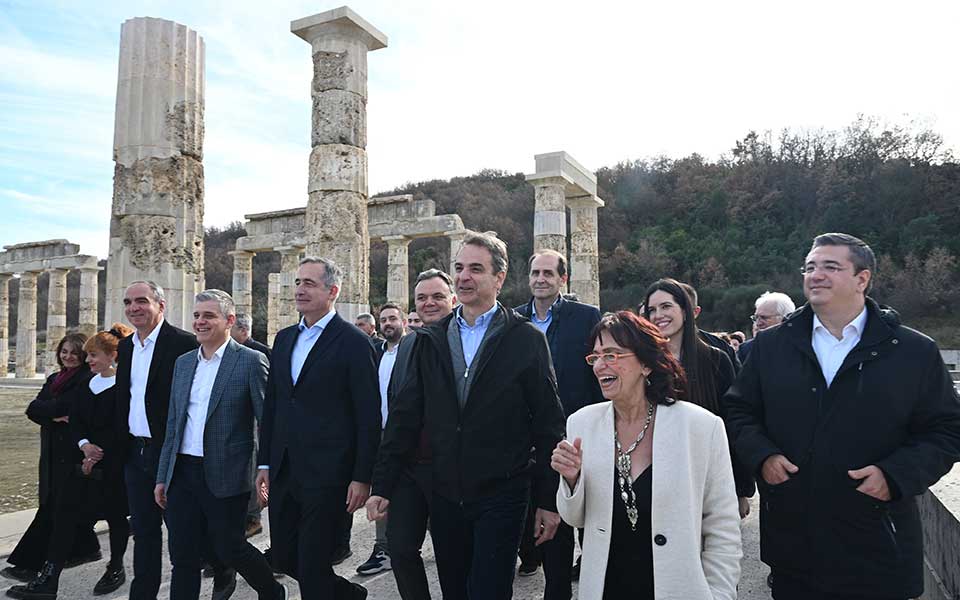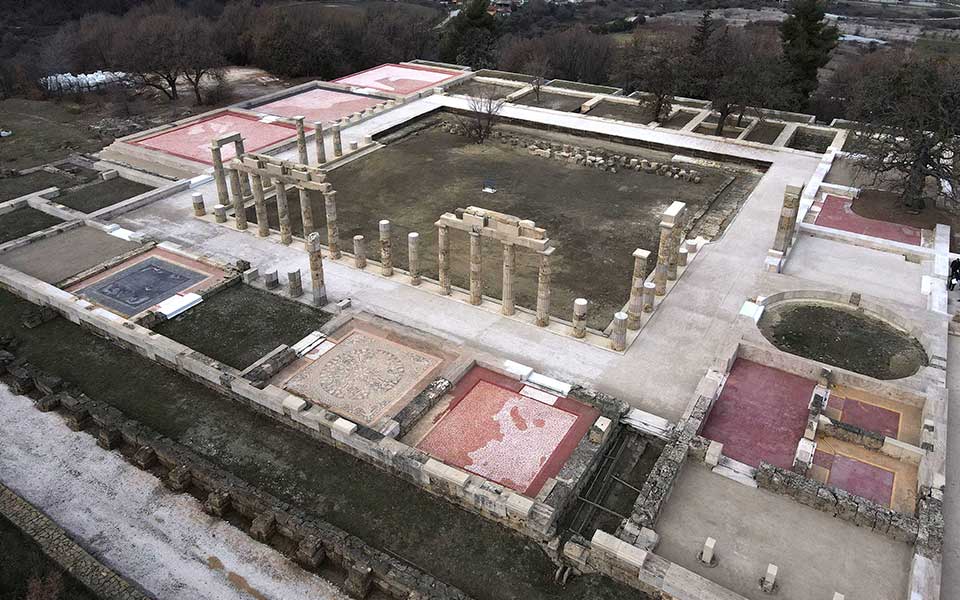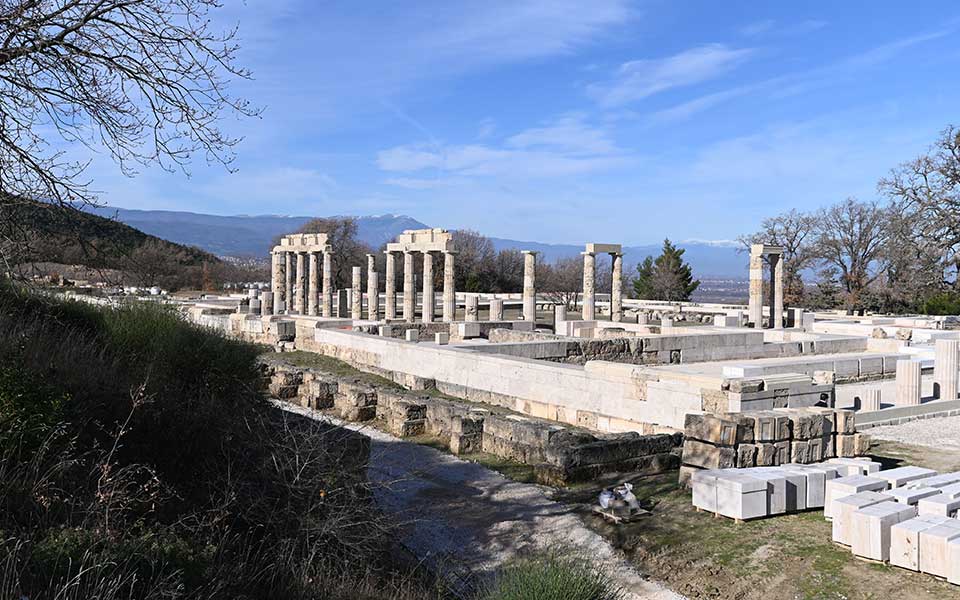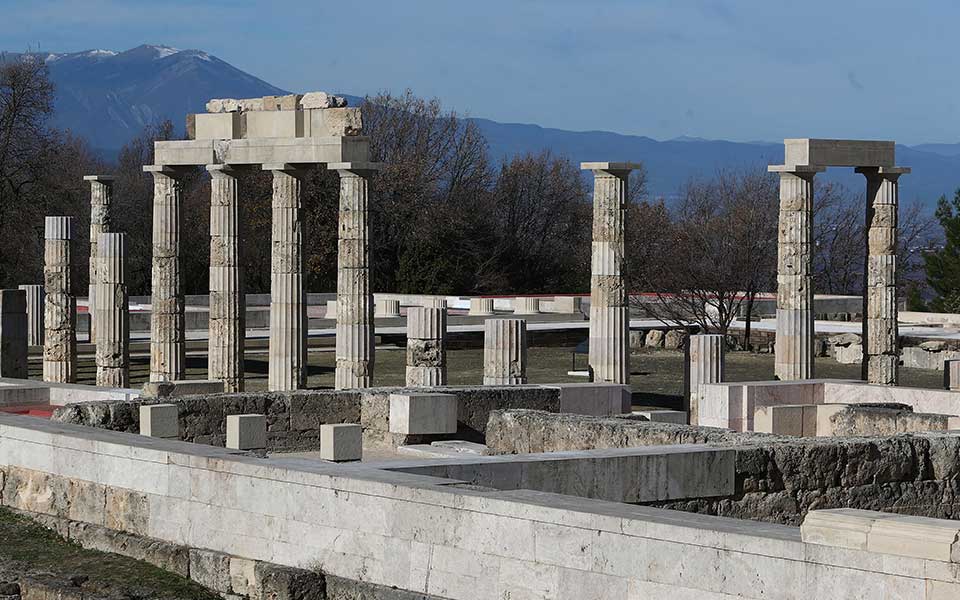Amid much fanfare, and in the presence of Greece’s prime minister, Kyriakos Mitsotakis, the restored ancient palace of king Philip II at Aigai was inaugurated earlier today in an official ceremony in western Macedonia, near the modern town of Vergina.
Aigai, deriving from the same root as the ancient Greek word “aiga” (goat), was the first capital of the Kingdom of Macedon, the seat of power of the ruling Argead (Temenid) dynasty, the family of Alexander the Great. Following 16 years of extensive restoration works, the monumental palace, the largest surviving building complex in Greece from the Classical period (5th and 4th centuries BC) – three times the size of the Parthenon – will now be open to the general public.
Described by German archaeologist and architectural historian Wolfram Hoepfner as the “Parthenon of Macedonia,” the vast peristyle palace covers an area of some 15,000 square meters. It was built in the mid-4th century BC by Philip II, father of Alexander the Great, and served as the “hearth” of ancient Macedonian religious and political life.

© InTime
“The Timeless Greek Heritage of Macedonia”
Embarking on a tour of the site, accompanied by local dignitaries and members of Greece’s Ministry of Culture, the prime minister hailed the global significance of the restoration project, emphasizing its role in reaffirming “the timeless Greek heritage of Macedonia.”
Addressing the crowd during the inauguration ceremony, Mitsotakis also talked about the necessity of transforming such historical monuments into catalysts for economic growth. “The significance of such monuments becomes the heritage of the entire world. We must highlight it, promote it, and expand the horizons revealed by each new facet,” he said, pledging a political effort to increase the number of visitors to the site. “The more visitors, the more the economy will be stimulated, and the more dynamically this unique cradle of culture will radiate its influence to every corner of the world.”
The prime minister was guided around the monument by Dr Angeliki Kottaridi, head of the Ephorate of Antiquities of Imathia, and director the restoration project. Speaking earlier to Kathimerini, the veteran archaeologist discussed the significance of the palace, not just as the seat of royal power but as a gathering point for Macedonian elites to make political decisions: “The palace of Aigai is a building without an ancestor, built to give architectural substance to the idea of an enlightened hegemony, as interpreted by Philip II. It is a combination of the democratic institutions of the cities and royal power, which shows us that Philip was cultivating an image: that the king was one among equals.”

© InTime
Multi-purpose Building
Scholars believe the monumental palace was designed by the renowned Greek architect Pytheos, who famously built the Mausoleum at Halicarnassus, one of the Seven Wonders of the Ancient World. As described, the palace was a multi-purpose building, functioning as a court, religious sanctuary, and housed a large banqueting hall, the interiors lavishly decorated with mosaics and wall frescoes. There was also a library and on-site gymnasium.
The palace opened out onto the city, with two impressive two-storied porticos of the facade, seemingly inviting citizens into the space. It also incorporated an enormous peristyle courtyard, with 16 Doric columns on each side. With a surface area of some 4,000 square meter, the square could accommodate as many as 8,000 people, functioning as a large gathering space. It was here that the young Alexander, following the assassination of his father in the neighboring theater, was crowned in the summer of 336 BC. Alexander’s 13-year reign would be a turning point in European and Asian history, establishing greater contacts and trade between East and West.
Talking to Kathimerini, archaeologist Panagiotis Iosif, scientific director of the Museum of Cycladic Art in Athens, explained that the palace functioned as a landmark monument, both for Macedonia itself and the wider Hellenic world: “It is the place where Philip put his signature on what will follow, on what Alexander and his successors will go on to create in all the cities of the Hellenistic world.”
The palace was systematically destroyed following the annexation of the Macedonian kingdom by the Roman Republic in 146 BC. “There was nothing in its place, everything was moved. The monument was also used as a temporary shelter by the refugees of 1922 and there was literally chaos,” explained Kottaridis. “We recorded 30,000-40,000 architectural pieces, which had to find their real place. But now the monument has been restored to the nearest centimeter,” noting that a comprehensive scientific report will follow.

© InTime
Polycentric Museum
The ruins of the ancient city were rediscovered by French archaeologist Léon Heuzey (1831-1922) in the mid-19th century, and subsequent excavations revealed tombs and the remains of a large palatial building. In the 1970s, Greek archaeologist Manolis Andronikos (1919-1992) led excavations at the site of the Great Tumulus, a colossal burial mound, revealing a cluster of four royal burial chambers, including the tomb of Philip II, with its famous golden larnax (“ash-chest”) and crown.
Speaking to Kathimerini, Greek Culture Minister Lina Mendoni said of the restoration project: “On the one hand, there is the scientific, historical and archaeological importance, as it is attributed to a site that was previously flat: the architectural elements were scattered in the space, without anyone realizing the third dimension of the monument. Thus, the image of the largest building of Classical antiquity is now restored. On the other hand, there is the importance of development: the whole of the archaeological site and the elements that make up the new Polycentric Museum of Aigai – the Museum of the Royal Tombs, the Central Museum inaugurated last year by the prime minister, the palace of Aigai, the burial cluster of the Temenids, and the necropolis which we attributed in 2021, the listed church of Agios Dimitrios, the ancient theater whose restoration research is in progress, and any other monument that can be attributed to the public in the future – create a very large development potential in the area of Aigai, in the area of Imathia and in Northern Greece more broadly.”
The restoration of the palace was carried out by the Ephorate of Antiquities of Imathia from 2007 to 2023 and co-financed by successive European programs, with a total budget of 20.3 million euros.
With information in Greek from kathimerini.gr.












